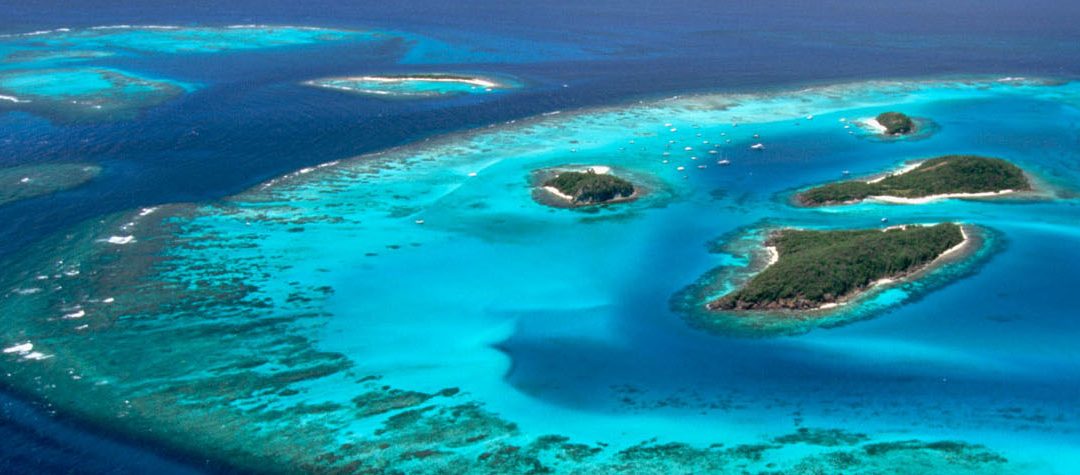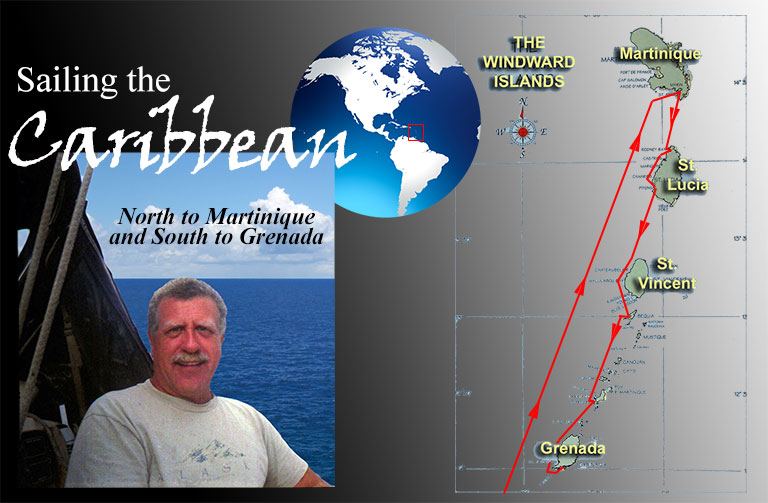
This two part video is from 1996 (old technology!) when Deb was away on a trip to Canada and our good friends Bill and Kaye were sailing southward from St Martin. I thought it would be a good idea to sail up to Martinique and sail back down the Windward Islands – St Lucia, St Vincent, The Grenadines and Grenada – with them.
North to Martinique
The first video (below) is Sailing North to Martinique and stopping in Marin and await Bill and Kaye arrival on s/v Free Spirit. Of course while you are there you may as well see something of the islands that you are anchored off. We get to play tourist for a little while. Mind you after doing this a few times it is much more fun to be your own tourist guide and discover the islands for yourself.
The trip North was in 25 knots of wind with 8 to 10 foot seas, rough but certainly sail-able. Glad to finally pull in to Marin – a bay on the South of the island of Martinique. Sailing seems to be quite popular in Martinique. There are a few “Hurricane Holes” where you can tuck a sailboat away. They are ringed with mangrove trees that are virtually impossible to pull out as they have very extensive root systems and make perfect mooring ties. The idea is to drop a couple of anchors off the stern or bow – depending on which way you want to lie (facing in or facing out), and run a couple of lines to the mangrove trees, and just tighten everything up. Strip everything off the deck and you are good to go. The truth is that if a Hurricane goes directly over your position there is no such thing as a “Hurricane Hole”.
See Sailing the Caribbean (Rough Guide) – Hurricanes.
Sailing South to Grenada
Since we only had a 32ft. sailboat and had a maximum hull speed of about 6.3 knots (1.15 x the square root of the waterline of the vessel), I always left any anchorage as early as possible so that sometime during the day Bill and Kaye in their 43 foot sailboat (faster maximum hull speed) would catch and pass. I would then be not too far behind them when we arrived at the next anchorage. This worked out quite well.
Scrap
When we left Canada we had a rather large cat on board with us who allowed us to adopt him after he was abandoned as a kitten in the ladies toilet in the Scarborough Town Mall. But after years of rolling around in the dust of the boat yards, and licking himself clean, he finally succumbed to stomach cancer (while we were in a previous visit to Martinique). We did an over night sail to St. Lucia where we took him to the local Vet, who also turned out to be the officer in charge of Animal Quarantine. He put Scrap to sleep and we buried him on top of Pigeon Island overlooking Rodney Bay. A British Admiralty defensive site since Fort Rodney was built in 1778. This was a sad time as he was a companion for many a sea adventure. This was the first time I had been back to Rodney bay since, hense the video footage of Pigeon Island.
The Pitons
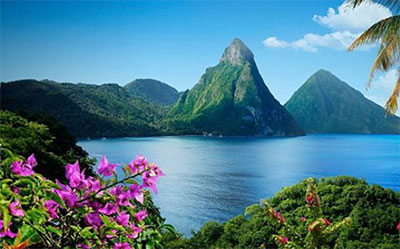
The Pitons are two volcanic plugs in a World Heritage Site in St. Lucia, linked by the Piton Mitan ridge. The two Piton Mountains are the most photographed landmark on the island. The larger of these two volcanic plugs is called the Gros Piton, while the other is the Petit Piton. We have always sailed past these two spectacular volcanic spires and never stopped. As the beach quickly drops of into some very deep water which makes any anchoring almost impossible. And the area always had a bad reputation. There is a new mooring park there now which has very large concrete blocks just off the beach, to which you can attach a mooring line. But I would not stay there in bad weather as if there is any west wind at all you are only feet from the beach and it would not take much of a swell to drop you on it. Much like the anchoring off the underwater park in Bonaire. Before the blocks were put in place you would normally drop an anchor as deep as your longest anchor line and reverse towards the shore and the boat boys would take your line ashore to tie off to the palm trees. Something you can do perfectly well for yourself by swimming or by using the dingy. Reports were out that the boat boys were very aggressive amongst each other in securing your business. The best way to deal with this was to pick the first one to arrive (or the biggest one) and negotiate a fee. If you were headstrong and did it yourself and did not pay one of the boat boys, they would simply cut the line to the palm trees in the middle of the night. And you would find yourself waking up the next morning well west of the island with a much shorter line still tied to the back of your boat. Now that the blocks are in place it has done the boat boys out of their “extortion” job. So they have resorted to stealing anything that can be lifted from the boats in the middle of the night. I can personally attest to this as I was over on Bill’s boat for about 15 minutes as dusk set, all the while watching Toucan only two mooring boys away. When I returned I found Toucan had been broken into and I had been robbed. Whoever it was, filled our large wash bucket with whatever they could find and floated it back to shore. They managed to take amongst other things, all my long pants. Which was embarrassing when I had to report to the Customs and Immigration on the next island, Bequia clad solely in my trunks! At first they took offense as this was not showing them the proper respect, showing up like a beach bum, but they understood once they had heard the reason why I was not suitable attired. Another reason for not staying at the Pitons and for sailing right by.
Tobago Keys
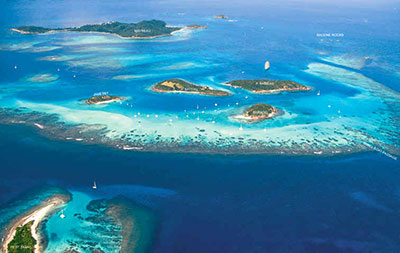
A cluster of 5 cays and an anchorage protected somewhat protected by the waves by a crescent reef. The water is crystal clear and it has a sandy bottom. Since there is only open ocean to the east you get a nice breeze all the time going through the anchorage. A relief in the hot Caribbean sun. Not an anchorage to stay in if the weather is not in your favor. It is a strange feeling to anchor there in what seems to be swimming pool water, it is so clear. One of the few times you do not have to dive and check your anchor, which was one of our constant practices (wherever it was possible). But the water being so inviting you could not resist having any excuse to dive straight in anyway. It is slightly unnerving to work your way in to the area through the reefs, and this is where a good cruising guidebook is invaluable. In the early 1990s the area was not crowded with only a few boats on anchor, and was some of the best cruising grounds in the world. Towards the latter 1990s the anchorage became far more crowded, to the point where boat boys would cruise the anchorage in open fishing boats or pirogues with water and ice and fish and lobster for sale to those on anchor. How times change.
Hurricane Bertha mentioned in the video (Wikipedia)
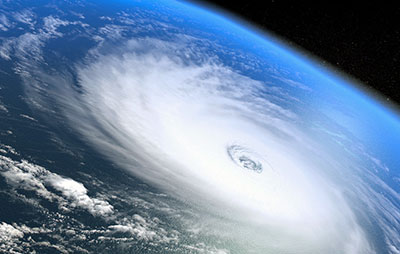
As Bertha passed through the northern Leeward Islands, it caused moderate to severe damage. In the United States Virgin Islands, heavy rainfall, hurricane-force winds, and significant property damage was reported. In addition, many boats were destroyed. In Puerto Rico, effects from Bertha were very similar to those in the U.S. Virgin Islands. One death was directly attributed to Bertha when a tourist drowned in rough seas in Luquillo, Puerto Rico. The most devastating effects from the hurricane occurred in the United States, more specifically the state of North Carolina. Several fishing piers, marinas, and boats were destroyed as a result of Bertha’s storm surge, and buildings across the eastern portion of the state were significantly damaged. In total, twelve fatalities were caused by Hurricane Bertha, primarily in Florida from rough seas.
Secret Harbour Marina and The Moorings (Mt Hartman Bay, Grenada)

Secret Harbour’s original English name was Mosquito Harbour, I guess that did not seem attractive to the tourists for the 5 star chalet hotel and marina in the bay – The Moorings. For the sailor it is ringed with mangrove trees and is far enough South to be out of the main Hurricane paths (there is always an exception – Hurricane Category 5 Ivan Sept 2004 see this You Tube video) we always anchor in the North West section of the bay adjacent to the marina docks. You get fairly good protection from the winds here and there is rarely a swell coming in from the sea. And if any serious adverse weather should develop there is always the mangroves right there. Besides all the amenities of a marina, and the Rum Squall bar, and mini food shop, and a gorgeous swimming pool right next to us, there is a taxi/mini bus run (expensive) that goes to St.Georges – the main town. The Customs and Immigration were a half hour walk over the Mt Hartman peninsula, which made it easy to check out of the country. When we anchored off this time in July it was the rainy season (see near the end of the video). And if you have a rainwater collection system like we had (a canvas sun cover that could be inverted with a hose attached to the middle) you could fill your fresh water tanks and all the auxiliary containers in 10 min. Which saved hauling the containers to shore in the dingy and paying EC .40 /gallon at the marina and hauling them back on board the boat.
Overall you start to avoid the sun while in the Caribbean, the novelty quickly wears off. and the canvas sun cover is a blessing. Especially if you are staying for a few weeks. Even although the boat has a white deck and reflects the suns rays, inside the boat can be like an oven in the tropics (10 Deg North of the Equator). With the canvas cover and a breeze blowing underneath it the inside of the boat can be 10 deg C cooler, and much more pleasant. While in the Carenage, St. Georges, the locals (and us) seem to always walk on the shaded side of the streets, and only the tourists can be seen on the sunny side. Being aware of this you seem to arrive to your destination without being drenched in sweat. After a few years in the Caribbean living on a boat, you slowly turn nut brown anyway as you cannot completly avoid the sun, even by staying in the shade on the boat, as it reflects of the water and gets you from below.
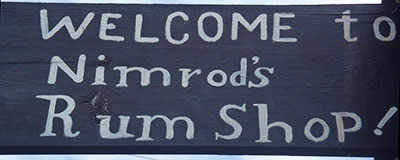
Another option of getting to St.Georges from the South Shore at Secret Harbour is a fairly long dingy ride 2 bays over to Woburn Bay, and a regular No. 2 bus trip to the capitol town. But unfortunately this route brings you past Nimrods Rum Shop. One of the true authentic local bars in the Caribbean. Nimrod has the tradition of welcoming any new sailors with a 2 1/2 oz glass of 86% Clarks Court rum, and a request to sign the guest book. After you sign the book, you are given the rum and a small side glass of water, and you wonder what the water is for. The tradition is to down the rum in a one-er. After you complete your initiation and your gums go numb, now you now realise what the water was for – to put out the fire. This tradition has scuppered many an attempt to get the bus to St. Georges, as the prospect of fighting the crowds in the market and hauling bags of groceries back across the bottom of the island in a hot bus seems pointless, as you are now quite legless, and lucky to make the long dingy trip back to your boat in Secret Harbour!
Grenada – The Spice Island
(nutmeg, mace, ginger, cinnamon, turmeric, cloves and cocoa)
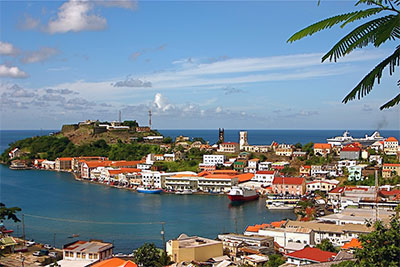
One of the truly great Caribbean islands, and the most Southerly of the Grenadines (Windward Islands). A visit to St. Georges is a must. The Carenage (horseshoe shaped town docks) gets it’s name from the sailing ships who used to visit in the islands past, to have their boats careened (turning a ship on it’s side for cleaning, caulkin or repaired). It is very picturesque and is what I always imagined the Carribean to look like with all the different coulored houses dotted in an infinite array all around the bay. It is also visited by the large cruise ships from time to time to disembarque their passengers for the day. A must visit is the famous but (oldy) Nutmeg Restaurant and Bar, where you can sit upstairs and soak up all the atmosphere and watch all the goings on below in the Carenage and harbour, and try some local callaloo soup with a conch roti (or a cheeseburger for all the parrotheads). Go early (11 am) if you want a waterside seat.
After a quite few sailing trips to Grenada’s south and West shores, we decided it would be a great idea to rent motorbikes and do a tour of the island. And see some of the interior. So we thought that a trip to Weather station the top of Mount St Catherine would be do-able, before completing the circumnavigation of the island. The trip was excellent until we arrived at the last section before the weather station. The road turned into 2 narrow strips of concrete that were on such a steep incline that you had to put the dirt bike into 1st gear and your stomach over the handlebars and lean as far forward as you could and try and stear on one of the strips of concrete. After about 10 min of this we finally arrived at the station. During the assent the angle of the bike meant that some of the oil in the crankcase had run down into the exhaust and the bike was shooting out flames from the rear, but I was so far forward that I did not see this until I arrived as stopping at any point would not have been good. It must have been some sight – some guy flying up the hill with a jet propelled bike! They station personnel were very surprised to see us as they never had tourists there before. They let us climb the communication tower situated on the top of the mountain from where you could see the whole island of Grenada down below – from the North to the South shores!
All in all – a great sail in some of the best cruising grounds in the world!
2,579
